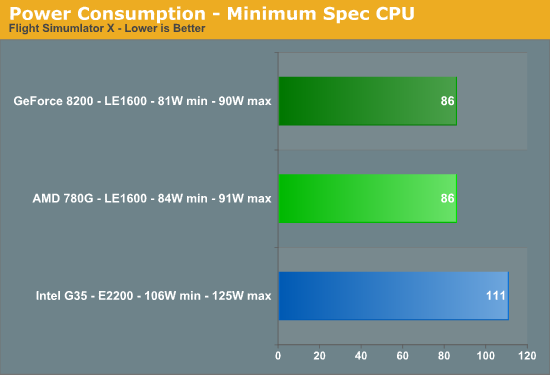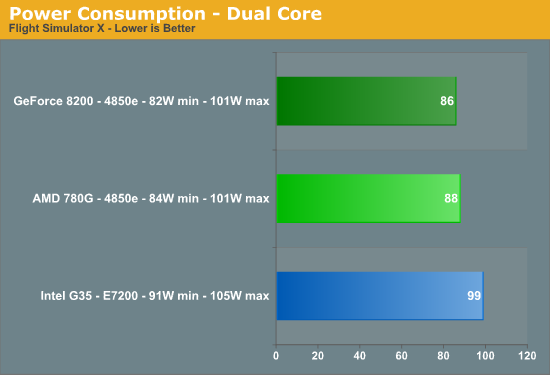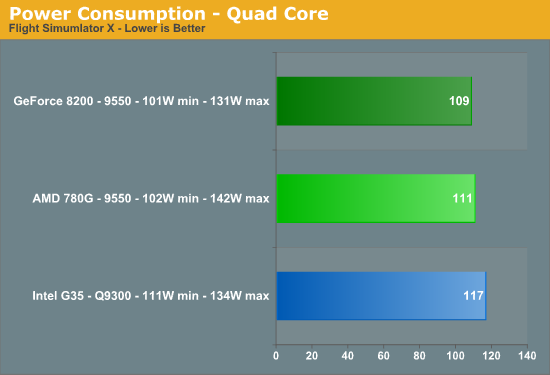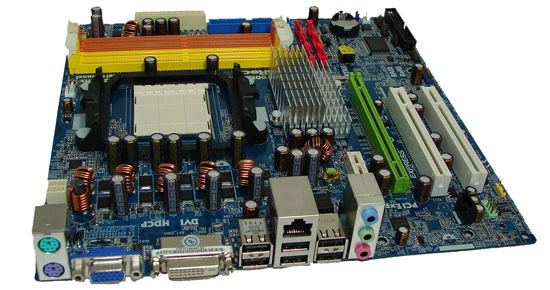IGP Power Consumption - 780G, GF8200, and G35
by Gary Key on April 18, 2008 2:00 AM EST- Posted in
- CPUs
Flight Simulator X Test
Whether playing Solitaire since the Windows 3.0 days or flying around your favorite locale in the longest running series on the PC, casual gaming on the PC is an activity just about everyone with a PC has done at one time or another. Our test today consists of a flight around the Honolulu harbor area and is something all three chipsets can handle, with the appropriate settings and resolutions. The actual winner is the 780G chipset, but what we are concerned about is how many dollars your electric company will collect when you relax and play a game.



We listed minimum and maximum voltages during our six-minute trip around the harbor, but the charts show the average. The current version of Flight Simulator X with the Acceleration Pack is fully multi-core aware and provides a workout for both the CPU and GPU as you crank up the settings. Our AMD LE1600 is a single-core CPU so the voltage variations are not as great compared to the multi-core CPUs. This processor stayed near the 100% utilization level during FSX testing, although frame rates did not seem to suffer that much at our 1024x768 medium settings.
The results are closer this time around between our two AMD platform chipsets. The GeForce 8200 once again finishes slightly in the lead but our upcoming gaming tests will show it following in the footsteps of the AMD 780G. The results are a tie between the AMD chipsets but a 25W advantage over G35 with the low-end processors, a 2W and 13W improvement with the dual cores, and a soft landing with 2W and 8W differences between the quad cores.

First Thoughts
We told you it would be a short article. However, we think the results today should provide a better indication to each platform's power requirements with a variety of CPUs likely to end up in these boards and applications that tend to stress those same processors. Unless the next NVIDIA driver set increases power consumption, then we have a surprise winner between the latest IGP chipsets from the big three. The next question we will answer is performance per watt and those results are likely to lead us down another path.
The power bill savings alone are not that large, of course. Running 24/7, 365 days per year, a 10W power difference works out to 87.6 kWh of energy over the course of a year. At a rate of 10 cents per kWh, that would work out to less than a dollar per month. In the bigger picture, however, the 5W to 25W difference between chipsets or platforms can be far more meaningful. If you want a silent - or at least very quiet - PC, every watt saved can be meaningful. Cooler running chipsets can also avoid the need for "noisy cricket" fans or monstrous cooling configurations. All other things being equal, we would definitely prefer less power-hungry components.










44 Comments
View All Comments
LuxZg - Friday, April 18, 2008 - link
First, I have to agree with Black Jacque, again I see reviews of low power systems done with higher power supplies, which is not good. Out of those 100-130W you probably have another 10% wasted power on PSU inefficiencies, which is sometimes as much as you save by choosing "right" chipset/CPU combo.Anyway, now that we know which chipsets are good and low power, and that they can run HD video, could you make an article that would show an alternative power source of around 180W? Let's say solar cells? I saw an article like that a while ago on Tom's (found it! http://www.tomshardware.com/reviews/technical-foun...">http://www.tomshardware.com/reviews/tec...dations-... ) and it would be nice to see a similar "investigation" after you finish this IGP comparision series :)
Calin - Friday, April 18, 2008 - link
You are comparing the performance of an AMD single core (LE1600) processor against the dual core E2200 from Intel?Conroe - Saturday, April 19, 2008 - link
Why not test with a 440? It's not that anyone would recommend a single core now with prices as they are. In my opinion dual core are even more green as you almost double processing power only adding a few more watts to the total. Either way I'm sure G35 still uses more power.Black Jacque - Friday, April 18, 2008 - link
I note they used a Corsair CMPSU-520HX for the testing. This PSU is inappropriately sized for the wattages reported.To get the highest efficiency out of that power supply you should run at about half its rated wattage.
strikeback03 - Friday, April 18, 2008 - link
Might be the smallest PSU they have around. Other than the small Seasonics and the Antec Earthwatts series, are there many power supplies in the 300-400 watt range that are reasonably high quality and more efficient?Side note: Love how Newegg's "Play it green" banner shows an Antec TruePower Quattro 1000. Nothing says green like a thousand watt PSU.
cghebert - Friday, April 18, 2008 - link
The ECS version of the 8200 is available nowhttp://www.newegg.com/Product/Product.aspx?Item=N8...">http://www.newegg.com/Product/Product.a...N82E1681...
But I believe the rest won't be released until later this month due to incomplete drivers from Nvidia at this point.
Gary, another great teaser article. I'm still sitting on my hands waiting for the full 780g and geforce 8200 roundup. Will any of the tests be done under Windows XP, or will it all be Vista?
Martimus - Friday, April 18, 2008 - link
That's a good question. I know that I plan on using Linux on my HTPC that I am building. (planning on a 780G and 4850e X2, but may change my mind based on your article)Also, does the 4850e X2 come with a quiet heatsink, or is it rather loud? I am trying to make the system as quiet as possible.
gogos7 - Friday, April 18, 2008 - link
You used an Asus motherboard in the Intel configuration.Asus M/Bs (the last 2 years) are well known for their high power consumption.
What do you expect?
sprockkets - Sunday, April 20, 2008 - link
They are the only one at the time that have a G35 board available.R3MF - Friday, April 18, 2008 - link
I am sat on a wad of cash looking to buy a mATX gaming system for a SUGO 03 case, and completely stymied by the lack of decent AM2+ boards capable to REALLY taking 125W load processors.Both MSI and Abit have solid-caps 8200 boards advertised which is great, but there is complete silence over when they will be released!
When can i buy an 8200 board?